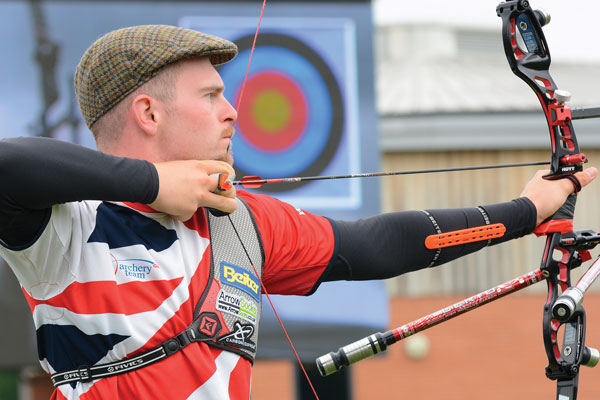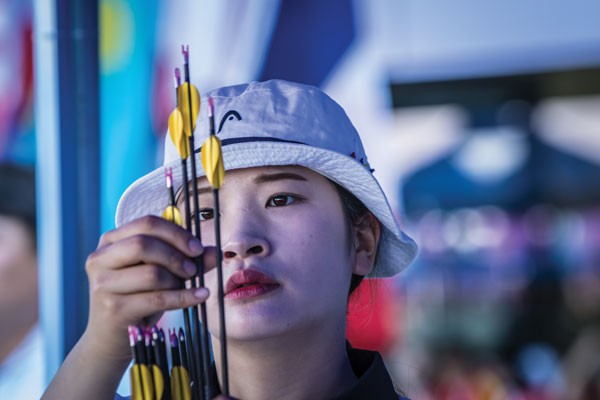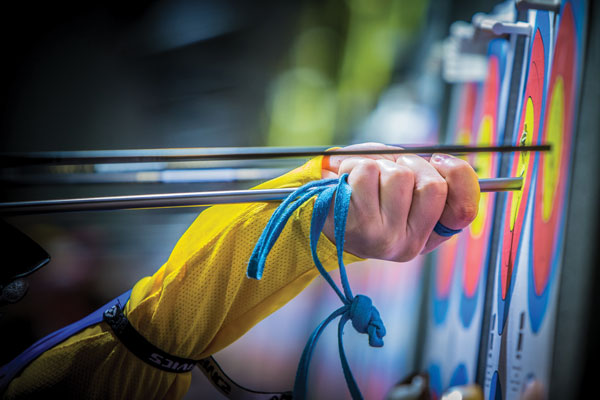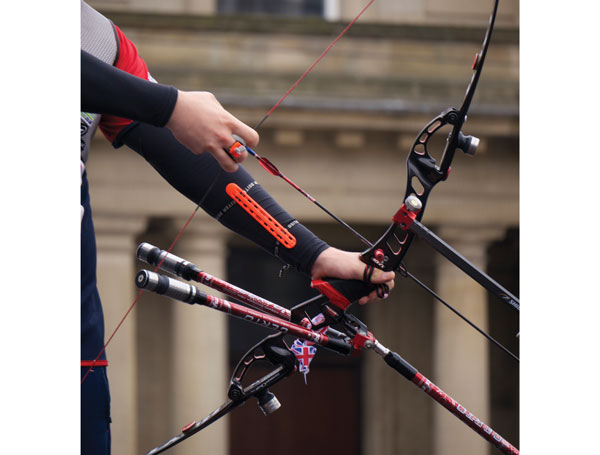Patrick Huston continues his guide to selecting the right equipment – this time looking at arrows and a tuning counterpart of theirs – pressure buttons

What shaft you buy depends on where you are shooting
I cover a lot of stuff in this article so I’d recommend you simply jump to the section you’re most interested in and read that. I do tend to ramble a little when I give my opinion on stuff, but in doing so I hope to make my thought process behind what I say clearer, and set out my opinion besides presenting the facts. There’s one more article in this series to cap off all of the equipment and then I promise I’ll leave it alone for a bit! You’ll be glad to know that I won’t even touch on the huge topic of strings – I know my limitations and trust Reign Bowstrings to provide me with what I need to perform.
First off, I’m going to talk about actually selecting which arrow shafts you are going to buy! I touched on this in the previous edition, but want to go through the options in a bit more detail here. Indoors we have carbon and aluminium to choose from – aluminium is the accepted standard given the years of use it has had, and arrows made from it are also exceptionally high tolerance. Look at the Easton X23 or XX75 for aluminium shafts. However, advancements in carbon technology means the products of Carbon Express, Gold Tip and others are seriously catching up. I’ve personally shot some of my best indoor scores with X Busters, but the X Jammer, GT 22 and CXL are all proven all-carbon indoor arrows with big scores and big names trusting them for the indoor season. I’m personally going to experiment with Carbon Express Maxima Recurves for the coming indoor season – these are a mid-diameter arrow with very low grain per inch. I’ve also seen many good indoor scores shot with Easton Lightspeeds, and they’re not prohibitively expensive.
Field archery sees many of the top archers just shooting the top-end arrow from their manufacturer, but with most serious field archers sat at 60# on the wheelybows and 50#+ for the strugglesticks this means we can get away with heavier arrows. You’ll see many field archers choosing to shoot Easton ACEs as they are lighter in weight for the spine, but ACCs have a similar weight to spine ratio until you get heavier in poundage and are easier on your pocket than ACEs. Tech Mckinneys are some of the lightest shafts on the market and come out like a rocket from your bow!

Spin Wings are a popular choice, but are delicate and can damage easily
For outdoors we really have one choice to consider – whether we go for an arrow with an aluminium core and a carbon outer, or solid carbon. The X10 is the market leader for recurve shooters having been in existence since the 90s, and is definitely the dominant arrow, taking every single Olympic medal in Rio. However, Carbon Express are creating some seriously high quality products with the Nano Pro Extreme and the rest of the range. I’m considering the top-end product here, but the same thoughts apply, if not more so, as we go down the price bands. The X10 has a baralled shaft, meaning the carbon layer decreases in width from the centre to the ends, weighting it towards the rear end. This supposedly gives it better flex patterning around a recurve release. Nobody can argue it works given its track record. By contrast, the Nano Pro Extreme is a parallel all-carbon shaft. It has varying spine sections in it in order to straighten fast out of the bow and create the most forgiving arrow dynamic while attached to the string.
This is the marketing blurb – but both arrows shoot 10s, many 10s, if shot well. Another element to consider is how they last shot after shot. The aluminium cored arrows such as X10s, ACCs, ACG, Full Metal Jacket and so on are a great product range, but over time the tube in the centre starts to wear out and lose its straightness. This is particularly true if you’re shooting into straw bosses, or if you’re grouping tight enough to start bashing arrows. You won’t notice arrows instantaneously landing in the wrong place, but over time the groups will steadily increase in size. This can happen slowly enough for you to not realise it is happening.
Solid carbon shafts, such as the Nano Pro Extreme, Nano SST, Nano Pro RZ, and Maxima, contain only carbon layers in weave directions. This means that they remain totally straight and maintain their spine consistency season after season. I wouldn’t just parrot the PR department, but I set my World Record with my Nano Pro Extremes after shooting them for two and a half years! I don’t believe I could have done that with an A/C arrow.
On arrows I can really recommend you guys have a look at the services offered by Custom Made Arrows. Adrian Tippins has written a fair few articles in this magazine and the detail and accuracy with which he puts together a set of arrows, along with wraps from ArrowSocks, is worth the slight increase in cost. Bear in mind that if you often pay for a shop to cut/point/nock your arrows it’s definitely worthwhile taking a look at Custom Made Arrows.

both arrows shoot 10s, many 10s, if shot well. Another element to consider is how they last shot after shot
Vanes
This article I’ll talk about vanes, and do wraps and nocks in the next one. Now there really are quite a lot to choose from. Outdoors you want something small – so no feathers or big plastic vanes. If you are new to outdoor archery and are missing the target regularly, first, move to a more comfortable distance as it’s just disheartening, but second, realise glue-on vanes are probably your better option. The Bohning Air vanes are what I’d recommend for a recurve archer – they are sleek, light and rugged – but there are several low-profile glue-on ones available so there is room to experiment if you like.
In terms of stick on spin-type vanes, the choices are Spin Wings, XS Wings, Eli Vanes or Gas Pro vanes. To be honest, they all work and have all been shot by a lot of top-level archers to high standards.
Spin Wings have been around since somewhere around the mid 80s. They do the job very well and hold most of the world records, and are popular with Korean archers (who, funnily enough, hold most of them) though they’re slow to change to new technology. Spin Wings can be damaged quite easily, given how flimsy they are, even in transit in your arrow tube.

The Beiter button is the most expensive available, but is preferred by top archers
Eli Vanes have been used to great success by a lot of archers. They also have an interesting indoor vane which is a high and long piece of Mylar with holes in the back for drag! They work well and have a nice texture and feel. The sticky tape comes in a big roll which I have found a bit of a pain to use, though others tell me you get used to it, and it works fine. These vanes work well and have a very wide and slightly confusing range of options to choose from. The only major downside I find with them is their very low profile means that, for tapered shafts, you have a limited amount of active surface area sitting above the centre of the arrow, and so being active in the wind.
XS Wings are my vane of choice and, given the consistent growth in the numbers of archers using them, I think archers of every level are really finding them a very good product. The first thing about them is the range of colours available, including pastel, fluorescent, a range of metallic shiny colours, and black and white, gold, silver and bronze too! Ben Sitar has created an easy sizing mechanism from 40mm to 100mm, with high and low profile vanes available in the 50 and 60mm models. Basically 40mm works well for short arrows and low poundage; 50mm is the standard and most widely used, slightly higher for a bit more stability; the 60mm low-profile is applicable for indoor skinny arrow use and the high profile is just wonderful for field archery where you want the short distance shots stabilised really fast; then the 100mm vanes are a great option for bigger indoor arrows. Or why not fletch your skinnies with them for indoors? I used to shoot a limited edition 80mm high profile and it was the best indoor arrow flight I’ve seen!

For outdoor target archery, a slim carbon or aluminium/carbon arrow is the best option, but these come at a cost
Pressure Button
Now the bit of equipment everybody fiddles with the most: the pressure button!
Pressure buttons provide tunability and adjustability to your set up. Having a reliable one really is crucial. I’m only going to talk about three here and you’ll see why. The cheapest option I would ever recommend going with for a pressure button is the Shibuya DX. It is a really solid, reliable and accurate button. It has a gold tip to reduce wear, a selection of springs and a replacement with it. It comes with allen keys to lock it down but doesn’t have click adjustment.
The Spigarelli Micro-Click button is at the lower end of the price scale for buttons with click adjustment. This you adjust and tune in quantifiable amounts, and you can swap between arrows before returning accurately to the same point. I can definitely recommend this.
The top end and international staple is the Beiter button. Yes, the price point is very much higher than the other two but the quality you receive is worth the investment. These things last decades! The micro adjustment clicks are very accurate, and it comes with three springs, spare tips and a neat storage box.
For the button I seriously recommend spending at least the £25-30 needed for the Shibuya button – the most basic buttons will set you back £10-15, and in my opinion the extra cash here is worth it. In all seriousness buttons can break, move, come loose and have to withstand a lot of shock and vibrations from your shot, so I recommend spending that bit more and getting one you can rely on. Click adjustment is a brilliant feature but buttons with it do cost a bit more – and the Beiter is the best you can buy but they do come with the associated price tag.
Shoot strong and prosper!
This article originally appeared in the issue 120 of Bow International magazine. For more great content like this, subscribe today at our secure online store: www.myfavouritemagazines.co.uk

